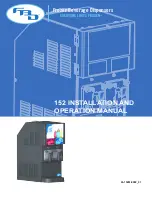
THEORY OF OPERATION
The SCR was designed to manufacture and dispense carbonated or non-carbonated
beverages much like your local bottling plant that cans or bottles your favorite carbonated
or non-carbonated drink.
Initially water is chilled and then carbonated to dispense a quality drink. To chill the water
the water is routed through a water coil that is submerged in an ice-cold water bath. The
temperature of the incoming water is at ambient temperature as it enters the water coil.
As the incoming water passes through the water coil the heat is removed from the water
in the water coil and chilled to a temperature acceptable for a quality drink. The water is
now routed into a carbonator tank where this cold water is mixed with CO2. This water is
now transformed into a carbonic acid, (soda water), and then routed to a remote station
and then valves where it will be mixed with syrup concentrates and dispensed.
The water bath holds approximately 9 gallons of water. A certain amount of this water
will be transformed into ice, approximately 35 pounds. This water reserve and ice bank
will act as a reservoir for refrigeration. This reserve is utilized during peak periods when
the BTU output of the compressor is not sufficient to meet the demand of the draw.
It should be recognized that without refrigeration your carbonation system would not
produce a drink that will hold carbonation. There is a direct relationship between
dispensed temperature and the volumes of C02 that can be held in liquid form.
The following will give a general overview of the flow of individual circuits and a clearer
understanding of our mini bottling plant.
Carbon dioxide gas (CO2) passes from a C02 cylinder through high-pressure regulator
(S-101). The high-pressure regulator regulates the CO2 feeding the SCR and should be
set at 65-75 PSI. The gas, after leaving the high-pressure regulator, is routed through
flexible tubing to a low-pressure regulator. The flow of CO2 is teed to go in two directions
at the low-pressure regulator. One path takes the gas, set at 65 to 75 PSI, to the
carbonator tank. This gas must be at a pressure greater than the incoming water by at
least 25-PSI to assure the proper function of the carbonator. The second path of C02 is
routed through low-pressure regulator to be regulated at pressures suitable for the syrup
concentrate being dispensed. The low-pressure regulator may be set at many different
settings but primarily the settings are directed towards B.I.B. or transfer tank type
installations. The average settings may vary from 10 to 60 PSI, this of course will be
influenced by length of run, ambient temperature and baume of product. Typically B.I.B.
installations are set at an average of 40 PSI and transfer tank installations are set at an
average of 30 PSI.
As discussed earlier plain water enters the SCR through the incoming water line. This
water proceeds through the water coil where it is chilled prior to entering the carbonator
tank or in the case of non-carbonated drinks chilled prior to going directly to a valve.
Prior to entering the carbonator tank an optional regulator (S-208A) may be installed.
This assembly is utilized to maintain water pressure feeding a non-carbonated valve
when used in conjunction with a carbonated valve.
The water source should be regulated, this is normally performed by the use of an in line
water regulator. If the water is not regulated and the water pressure is equal or greater
than the incoming CO2 the act of carbonation will be greatly inhibited or completely
eliminated.
14
















































